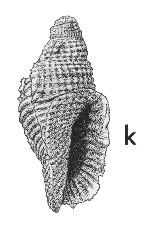
Revised descriptions of New Zealand Cenozoic Mollusca from Beu and Maxwell (1990)

 | Revised descriptions of New Zealand Cenozoic Mollusca from Beu and Maxwell (1990) | 
|
  (Pl. 8k): GS9481, J41/f8025, Lorne, inland from Oamaru, Kaiatan (TM5145, GNS) |
Beu & Maxwell (1990): Chapter 8; p. 127; pl. 8 k.
Synonymy: Cymatium revolutum Finlay 1924b, p. 456; Semitriton revolutum
Classification: Cancellariidae: Cancellariinae
Description: Moderately large for family (height 30-45 mm), broadly fusiform, spire 0.4 total height. Protoconch dome-shaped, of 1.5 smooth whorls, apex flattened. Teleoconch whorls convex on spire; last whorl long, broadly excavated, with moderately long, thick neck. Axial sculpture of narrow, low costae reaching from suture to suture on spire and across base of last whorl; low varices present down much or all of spire, but indistinct towards apex. Spiral sculpture of numerous, narrow, rather widely spaced, rounded cords similar in strength to axial costae; interspaces with fine, low threads cancellated by fine growth ridges. Intersections of spiral cords with axial costae nodulose. Aperture narrow, with a short, straight, widely open, unnotched siphonal canal; no obvious fasciole. Inner lip spread as a moderately wide callus pad with a thickened edge, bearing 3 prominent, narrow columellar plaits medially, and many narrow spiral ridges (most of them corresponding to spiral cords on base and neck) over whole callus. Outer lip wide, strongly thickened, inner face almost flat, with 14 prominent, narrow ridges.
Comparison: Tatara pahiensis (Bortonian, Pahi), the type species of Tatara Fleming, 1950, is known only by the holotype; it is larger and less slender than T. revoluta, has coarsely cancellate teleoconch sculpture lacking the finely reticulate interstitial sculpture of the latter species, has a very wide outer lip bearing 11 transverse ridges, and has four low, wide columellar plaits. T. flemingi (Pl. 9k) is similar to T. revoluta but is shorter and wider, has weaker axial sculpture but stronger secondary spiral sculpture, has a more laterally sinuous aperture (inclined at 20° to vertical), has a wider outer lip bearing 18-20 low, transverse ridges and has only two prominent (and a weaker third) columellar plaits. T. transenna (Suter, 1917) (Waitakian, "Isis" bed, Campbell's Beach, Kakanui) is a rather poorly known, relatively stumpy, low-spired, coarsely cancellate species; it has been interpreted in a very broad sense by Beu & Maxwell (1987) to include all of the younger Tatara records, although probably more than one species is involved. These include fragmentary specimens with beautiful reticulate microsculpture from Parengarenga Harbour (Altonian), and poorly preserved moulds from the Stillwater Mudstone at Greymouth (Clifdenian).
Tatara has traditionally been regarded as a member of the Ranellidae, but Beu & Maxwell (1987) showed that it is a cancellariid closely similar to Semitriton Cossmann, 1903. The genus is restricted to New Zealand, and includes both shallow-water species (e.g. T. pahiensis and possibly T. revoluta) and deeper-water forms (T. flemingi and T. transenna), mostly from "hard-ground" facies.
Distribution: Kaiatan (- Whaingaroan?); "Kakanui Beach (tuffs below the limestone)" (type — almost certainly from Waiareka Volcanic Formation, Lorne (Kaiatan), where this species is not uncommon (see comments under Haurokoa marwicki, above); ? Kakanui, top of McDonald Limestone (Whaingaroan).
Cite this publication as: "A.G. Beu and J.I. Raine (2009). Revised
descriptions of New Zealand Cenozoic Mollusca from Beu and Maxwell (1990). GNS
Science miscellaneous series no. 27."
© GNS Science, 2009
ISBN
978-0-478-19705-1
ISSN 1177-2441
(Included with a PDF facsimile file
copy of New Zealand Geological Survey Paleontological Bulletin 58 in CD version
from: Publications Officer, GNS Science, P.O. Box 30368 Lower Hutt, New
Zealand)